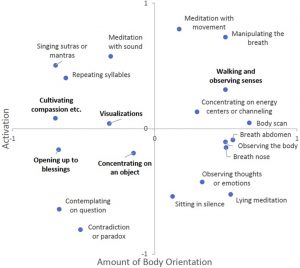Meditation Improves Health and Well-Being Through Epigenetic Mechanisms
By John M. de Castro, Ph.D.
“It seems unusual that something as simple and easy as meditating could improve your health, but these studies demonstrate an epigenetic link between meditation and its potential disease-reducing benefits.” – Bailey Kirkpatrick
Over the last several decades, research and anecdotal experiences have accumulated an impressive evidential case that the development of mindfulness has positive benefits for the individual’s mental, physical, and spiritual life. Mindfulness appears to be beneficial both for healthy people and for people suffering from a myriad of illnesses. It appears to be beneficial across ages, from children to the elderly. And it appears to be beneficial across genders, personalities, race, and ethnicity. The breadth and depth of benefits is unprecedented.
Meditation practice has been shown to improve health and longevity. One way it appears to act is by altering the genes which govern cellular processes in our bodies. The genes dictate all of the chemical processes in our bodies including immune and inflammatory responses. The ability of outside influences to affect gene expression is known as epigenetics. There have been a number of research studies of the of the epigenetic effects of mindfulness practices. So, it makes sense to summarize what has been learned regarding the epigenetic alterations in gene expressions produced by mindfulness practices to determine if these effects are the intermediary between meditation and health.
In today’s Research News article “Molecules of Silence: Effects of Meditation on Gene Expression and Epigenetics.” (See summary below or view the full text of the study at: https://www.ncbi.nlm.nih.gov/pmc/articles/PMC7431950/) Venditti and colleagues review and summarize the published research studies of the effects of mindfulness on gene expression.
They report that the published research found that sitting and walking meditation, Tai Chi, and Yoga produce wide-ranging changes in gene expression including slowing of the age-related methylation of the genes. They report that the epigenetic changes seen alter genes involved in metabolism, inflammatory processes, oxidative stress, and DNA damage response. In fact, they report that mindfulness practices produce epigenetic changes that are the opposite to those produced by stress.
These findings are important for understanding the ability of mindfulness practices to promote health and slow the aging process. By reversing the changes that stress produces in gene expression, mindfulness practices can prevent or reverse the harmful consequences of stress on the body. This may well be one of the mechanisms that underlie the health benefits of mindfulness practices.
So, meditation improves health and well-being through epigenetic mechanisms.
“a single 8-hour mindfulness meditation retreat can rapidly alter methylation levels that affect epigenetic expression in genes among experienced meditators. Involved genes include those that regulate inflammation, immune cell metabolism, DNA repair, cellular aging, RNA metabolism, protein translation, cell adhesion, and neurotransmission.” – AMRA
CMCS – Center for Mindfulness and Contemplative Studies
This and other Contemplative Studies posts are also available on Google+ https://plus.google.com/106784388191201299496/posts and on Twitter @MindfulResearch
Study Summary
Venditti, S., Verdone, L., Reale, A., Vetriani, V., Caserta, M., & Zampieri, M. (2020). Molecules of Silence: Effects of Meditation on Gene Expression and Epigenetics. Frontiers in psychology, 11, 1767. https://doi.org/10.3389/fpsyg.2020.01767
Abstract
Many studies have consistently demonstrated an epigenetic link between environmental stimuli and physiological as well as cognitive responses. Epigenetic mechanisms represent a way to regulate gene activity in real time without modifying the DNA sequence, thus allowing the genome to adapt its functions to changing environmental contexts. Factors such as lifestyle, behavior, and the practice of sitting and moving mindful activities have been shown to be important means of environmental enrichment. Such practices, which include mindfulness meditation, Vipassana, Yoga, Tai Chi, and Quadrato Motor Training, have been reported to positively impact well-being. In fact, they can be considered emotional and attentional regulatory activities, which, by inducing a state of greater inner silence, allow the development of increased self-awareness. Inner silence can therefore be considered a powerful tool to counteract the negative effects of overabundant environmental noise, thanks to its power to relieve stress-related symptoms. Since all these positive outcomes rely on physiological and biochemical activities, the molecular and epigenetic mechanisms influenced by different mindful practices have recently started to be investigated. Here, we review some of the findings that could allow us to uncover the mechanisms by which specific practices influence well-being.
https://www.ncbi.nlm.nih.gov/pmc/articles/PMC7431950/





